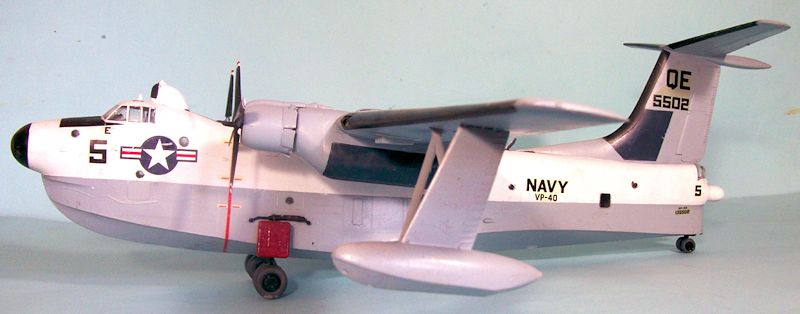
Hasegawa 1/72 SP-5B Marlin
| KIT #: | |
| PRICE: | $20 when new (which was a LOT of money for a model in 1973) |
| DECALS: | Three options |
| REVIEWER: | Tom Cleaver |
| NOTES: |

| HISTORY |
The last flying
boat operated by the U.S. Navy, the Martin SP-5B Marlin (P5M-2 prior to 1962)was
used around the world between 1951-66.
Developed from the early PBM Mariner series, the Marlin
was larger, and in the P5M-2/SP-5B variant had the most advanced hull used by
any flying boat other than the P6M Seamaster jet-powered flying boat.
Originally equipped with armor, self-sealing fuel tanks
and a twin 20mm tail turret, by the 1960s the armor and the tail turret were
gone to save weight for more electronic gear.
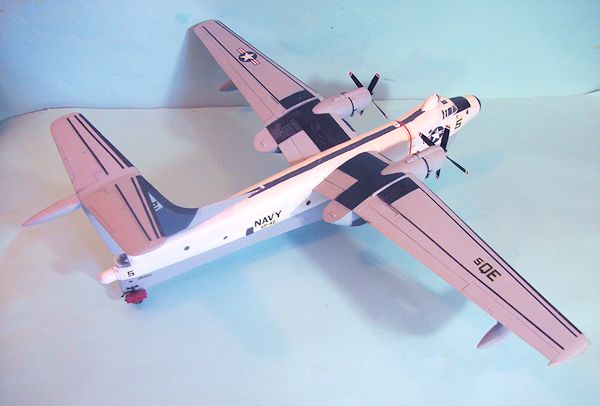 Naturally, under those conditions, the Marlin was the main US Navy ELINT
aircraft for patrols along the China Coast from the Yellow Sea through the
Taiwan Straits to Hainan Island.
The four West Coast squadrons, based at NAS North Island
(VP-48) and NAS Whidbey Island (VP-49 and VP-50), alternated tours in WestPac
with each other, though VP-40 operated from NAS Sangley Point, outside Cavite in
Manila Bay for several years as a permanent unit.
The squadrons also sent aircraft to Okinawa to operate
from Buckner Bay with the seaplane tenders USS Pine Island,
Currituck and Salisbury Sound.
In the early 1960s, International Law recognized the 3 mile limit to territorial
waters.
The People’s Republic of China began to claim the 12 mile limit to their
territorial waters in 1962, and the US Navy was told to fly their recon missions
at the 6 mile limit; still using World War II-era navigation technology, it was
not unheard-of for an airplane flying for an extended period of time over a
cloud deck to find a hole in the clouds, through which the crew could see green
and brown and tan, rather than blue, this engendering a turn to the east to get
back to the safety of international waters.
No airplanes were lost, but there were a couple
occasions I remember where the crews were able to make extensive close
examinations of Red Chinese MiG-17s hanging on the edge of a stall off their
tail.
Naturally, under those conditions, the Marlin was the main US Navy ELINT
aircraft for patrols along the China Coast from the Yellow Sea through the
Taiwan Straits to Hainan Island.
The four West Coast squadrons, based at NAS North Island
(VP-48) and NAS Whidbey Island (VP-49 and VP-50), alternated tours in WestPac
with each other, though VP-40 operated from NAS Sangley Point, outside Cavite in
Manila Bay for several years as a permanent unit.
The squadrons also sent aircraft to Okinawa to operate
from Buckner Bay with the seaplane tenders USS Pine Island,
Currituck and Salisbury Sound.
In the early 1960s, International Law recognized the 3 mile limit to territorial
waters.
The People’s Republic of China began to claim the 12 mile limit to their
territorial waters in 1962, and the US Navy was told to fly their recon missions
at the 6 mile limit; still using World War II-era navigation technology, it was
not unheard-of for an airplane flying for an extended period of time over a
cloud deck to find a hole in the clouds, through which the crew could see green
and brown and tan, rather than blue, this engendering a turn to the east to get
back to the safety of international waters.
No airplanes were lost, but there were a couple
occasions I remember where the crews were able to make extensive close
examinations of Red Chinese MiG-17s hanging on the edge of a stall off their
tail.
During my time in
the far east, VP-40 was the unit that we operated with most closely; being a
life-long aeronut, I was crazy enough to think a 12 hour flight in a flying boat
was more interesting than a liberty ashore, and I managed to cadge several
flights then, with QE-5, callsign “Seashell-5" being the airplane I flew in more
than once.
The Great Galapagos Adventure:
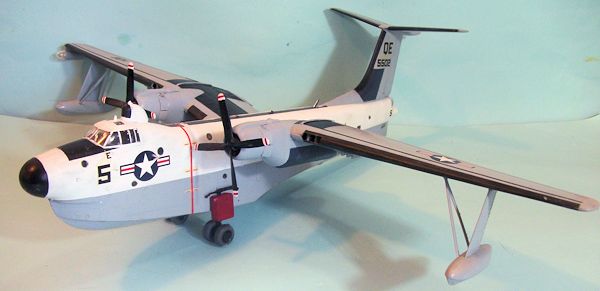 To me, the most interesting six weeks of my naval career was a trip to the
Galapagos in 1964.
There are only a few mentions of the 1964 Galapagos
Expedition, and the only one by other participants is a very good page on the
VP-48 website that tells the story from the aviator’s recollection.
There is, also a sub-page at the site which has a copy
of the “Crossing the Line” booklet that was presented to all of us on USS
Pine Island.
You can see it at:
http://www.vp48.org/index_page0315.html
To me, the most interesting six weeks of my naval career was a trip to the
Galapagos in 1964.
There are only a few mentions of the 1964 Galapagos
Expedition, and the only one by other participants is a very good page on the
VP-48 website that tells the story from the aviator’s recollection.
There is, also a sub-page at the site which has a copy
of the “Crossing the Line” booklet that was presented to all of us on USS
Pine Island.
You can see it at:
http://www.vp48.org/index_page0315.html
Click “Crossing the Line Initiation” (I think I
actually found a picture of yours truly emerging from the “Tunnel of Love” but
that was a long time ago and we all looked different then)
Here is my
recollection:
Perhaps the most
interesting mission undertaken by the SP-5B Marlin was the operation of four
SP-5Bs of VP-48, flying from an advanced seaplane base operated by the USS
Pine Island (AV-12) to support the
International Galapagos Project in January and February, 1964.
In the 1950s, the environmental alarm had been sounded
about the condition of life in the Galapagos - the site of Darwin’s first
investigations that led to his describing the crucial theory of evolution in
“The Evolution of Species” published in 1859.
Before Darwin’s visit aboard HMS Beagle in 1835, the
islands had been used for the previous 150 years by English pirates, whalers,
fur sealers and others, and the native animal population was already in decline
by 1835.
In 1959, Ecuador declared the Galapagos a national park, and with the
support of the Charles Darwin Institute, a fifth expedition was mounted by the
California Academy of Sciences (which had made expeditions to the islands since
1906) to perform the most thorough examination of native animal life since
Darwin’s work in 1835 as part of the work to establish the park.
The U.S. Navy decided to provide support for the
expedition, since it would provide the seaplane tender USS
Pine Island with the opportunity to perform remote sea base
operations in the islands.
Pine Island departed San Diego with the
scientists of the expedition around January 7, 1964, as I recall, with the first
port of call being the Panama Canal.
We arrived in Balboa just after a series of
anti-American demonstrations January 9-12 (this is known as Martyr’s Day in
Panama and is the event that eventually led to the U.S. handing the canal over
to Panama 15 years later) and the ship only remained two days before heading out
for the Galapagos.
The islands straddle the Equator, and so on January 20,
500 or so Pollywogs, including yours truly and the Chief Pollywog,
Pine Island’s Captain (later VADM and CTF-77 in 1972),
Damon W. Cooper, were initiated into Neptune’s Realm in the traditional
celebration.
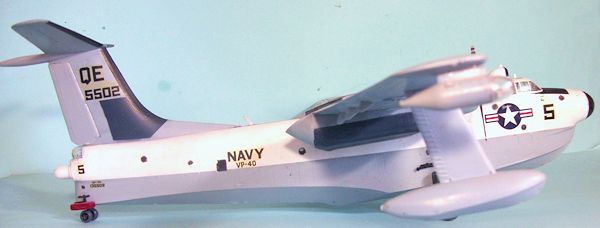 About the same time we were crossing the Equator, the
Marlins departed NAS North Island, headed non-stop for
NAS Corpus Christi, Texas.
While three managed to get into Corpus Christi before
the fog rolled in, the fourth eventually had a very adventurous landing at NAS
Pensacola.
Gathering all at Corpus Christi, they then flew down to Panama
and on to the Galapagos, where the Pine Island
was anchored off Baltra Island.
The crews arrived two days after
Pine Island had shed all her Pollywogs, and the 20 or so
Naval Aviators aboard the airplanes were initiated by a large group of former
Pollywogs, intent on “passing on the tradition.”
I am personally glad I was not one of them - being one
of 600 Pollywogs initiated by fewer than 100 Shellbacks was enough “adventure.”
I did, however, enjoy “passing on the tradition.”
About the same time we were crossing the Equator, the
Marlins departed NAS North Island, headed non-stop for
NAS Corpus Christi, Texas.
While three managed to get into Corpus Christi before
the fog rolled in, the fourth eventually had a very adventurous landing at NAS
Pensacola.
Gathering all at Corpus Christi, they then flew down to Panama
and on to the Galapagos, where the Pine Island
was anchored off Baltra Island.
The crews arrived two days after
Pine Island had shed all her Pollywogs, and the 20 or so
Naval Aviators aboard the airplanes were initiated by a large group of former
Pollywogs, intent on “passing on the tradition.”
I am personally glad I was not one of them - being one
of 600 Pollywogs initiated by fewer than 100 Shellbacks was enough “adventure.”
I did, however, enjoy “passing on the tradition.”
The Galapagos
were a fantastic place to see.
At the time, the human population was under 2,800,
living on only two islands (today the population is 25,000 on six); the other 11
looked pretty much exactly as Darwin had seen them 130 years earlier.
Over the next few weeks, the Marlins flew teams of
scientists and their naval “bearers” (of which I participated on one trip) to
the different islands (there are 13), and Pine Island
operated near Santa Cruz, Baltra and Isabella Islands. I for one will never
forget seeing the famous Darwin’s Finches (which are biologically all the same
finch, found on seven of the islands, each sub-species with a different bill
that allows it to fill a different ecological niche in that island’s ecology) in
their native environments.
Having the whole thing explained by a scientist who knew
what he was talking about helped too.
At the end of
February we returned to San Diego, with a stop in Acapulco (a very different
place from what one visits today). As a result, I always laugh when I see Elvis
Presley’s “Fun In Acapulco,” particularly a scene where The King dances and
sings on the street in front of a large green building - which happens to have
been the largest house of prostitution in the city at the time (ask me how I
know).
On their way
home, one of the Marlins blew a prop governor coming in to land at the seadrome
off Balboa.
With no way to perform the necessary engine change, the Marlin
was left behind and the crew flew a Pan Am 707 back to Los Angeles.
The Marlin Goes To War:
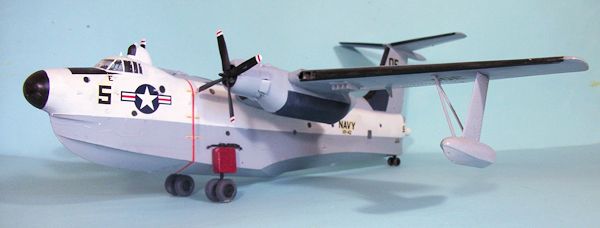 The SP-5B Marlin finally went to war in the aftermath of the (alleged) Tonkin
Gulf (non) Incident in August 1964, when
Pine Island, serving at the time
as the flagship of Commander Patrol Forces U.S. 7TH
Fleet (the command in charge of the destroyers Maddox
and Turner Joy and responsible for the
cock-up that was manufactured into a lie to provide excuse for a war) was
ordered to set up surveillance seaplane operations in DaNang harbor.
I had by that time been transferred to the PatFor staff.
During August, VP‑48 established a seaplane squadrons all‑time record, amassing
1,585 hours flight time as they patrolled the Gulf of Tonkin. Flying around the
clock, VP‑48 averaged two planes airborne at all times for the
entire month. Over the remainder of
Pine Island’s WestPac tour that year, seaplane
operations were undertaken at DaNang and at the Poulo Condore Islands off the
southern tip of southern Viet Nam.
VP-40 crews, which replaced VP-48 in September,
undertook the first aerial mapping of Cam Ranh Bay that fall, which led to the
installation of the major U.S. base there the next year.
The Pine Island,
Salisbury Sound and
Currituck began operating from Cam Ranh Bay (in
turn) from the summer of 1965 as part of Operation Market Time, the coastal
patrol of southern Viet Nam designed to cut off supplies from the North (which
were actually coming down the Ho Chi Minh Trail).
In November 1966, Pine Island
and VP-40 were the last seaplane units to operate there.
The next year VP-40 converted on to the P-3 Orion, and
Pine Island was retired, to be scrapped
in 1967 along with Currituck and
Salisbury Sound.
The SP-5B Marlin finally went to war in the aftermath of the (alleged) Tonkin
Gulf (non) Incident in August 1964, when
Pine Island, serving at the time
as the flagship of Commander Patrol Forces U.S. 7TH
Fleet (the command in charge of the destroyers Maddox
and Turner Joy and responsible for the
cock-up that was manufactured into a lie to provide excuse for a war) was
ordered to set up surveillance seaplane operations in DaNang harbor.
I had by that time been transferred to the PatFor staff.
During August, VP‑48 established a seaplane squadrons all‑time record, amassing
1,585 hours flight time as they patrolled the Gulf of Tonkin. Flying around the
clock, VP‑48 averaged two planes airborne at all times for the
entire month. Over the remainder of
Pine Island’s WestPac tour that year, seaplane
operations were undertaken at DaNang and at the Poulo Condore Islands off the
southern tip of southern Viet Nam.
VP-40 crews, which replaced VP-48 in September,
undertook the first aerial mapping of Cam Ranh Bay that fall, which led to the
installation of the major U.S. base there the next year.
The Pine Island,
Salisbury Sound and
Currituck began operating from Cam Ranh Bay (in
turn) from the summer of 1965 as part of Operation Market Time, the coastal
patrol of southern Viet Nam designed to cut off supplies from the North (which
were actually coming down the Ho Chi Minh Trail).
In November 1966, Pine Island
and VP-40 were the last seaplane units to operate there.
The next year VP-40 converted on to the P-3 Orion, and
Pine Island was retired, to be scrapped
in 1967 along with Currituck and
Salisbury Sound.
| THE KIT |
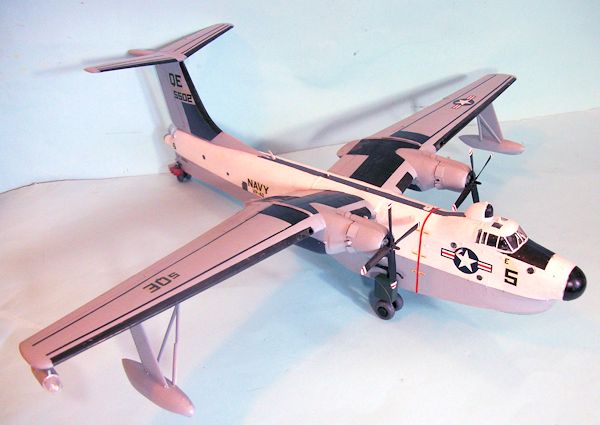
| CONSTRUCTION |
The one thing to
remember with the kit is that it comes from that era of “problematic fit” that
requires all parts to be test-fitted before assembly.
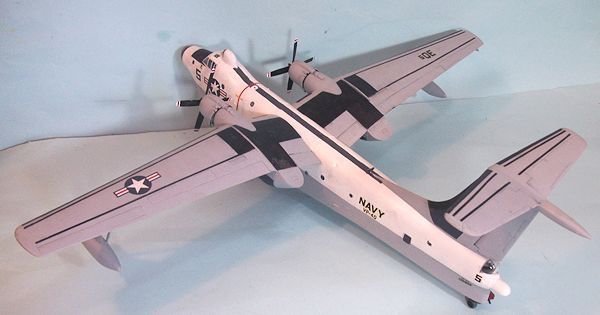
| COLORS & MARKINGS |
I first
pre-shaded the model with flat black, then painted the upper fuselage with
Tamiya Gloss White, I then masked that off and painted the Dark Seaplane Grey
areas of the wing, engine nacelles and vertical fin, using Tamiya Dark Grey for
this.
I then painted the de-icer boots and wing walks with Flat Black and
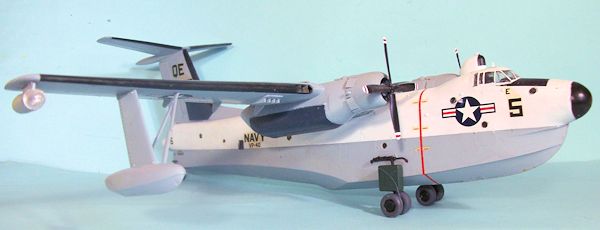 masked them
off.
I then painted the rest with “Light Seaplane Grey,” which I based on
Tamiya Sky Grey with a brushfull of Flat Blue.
When completed, I gave the model an overall coat of
Future.
masked them
off.
I then painted the rest with “Light Seaplane Grey,” which I based on
Tamiya Sky Grey with a brushfull of Flat Blue.
When completed, I gave the model an overall coat of
Future.
I gave the model
an overall coat of Xtracrylix Satin clear coat, then attached the propellers and
the beaching gear.
| CONCLUSIONS |
Kit courtesy of my wallet.
If you would like your product reviewed fairly and fairly quickly, please contact the editor or see other details in the Note to Contributors.